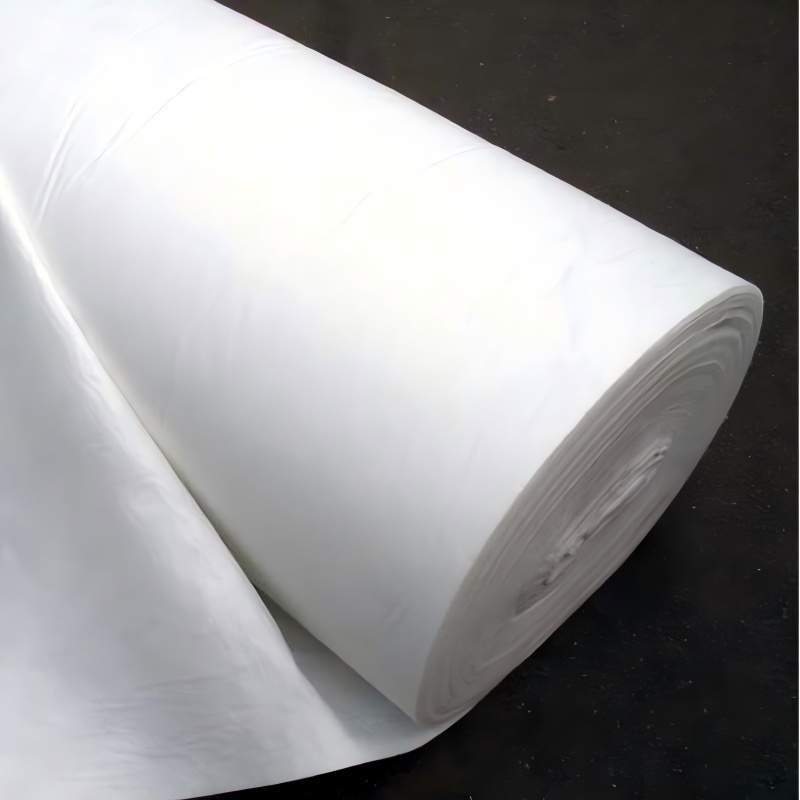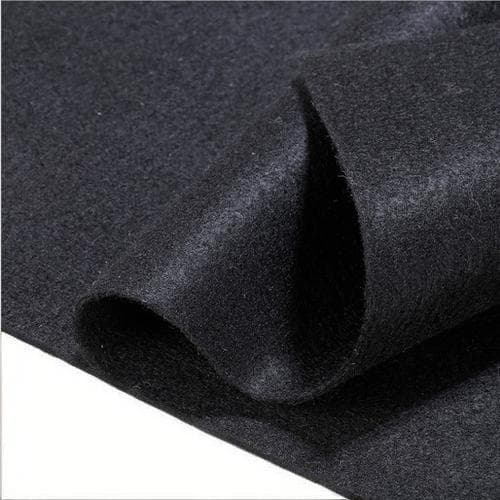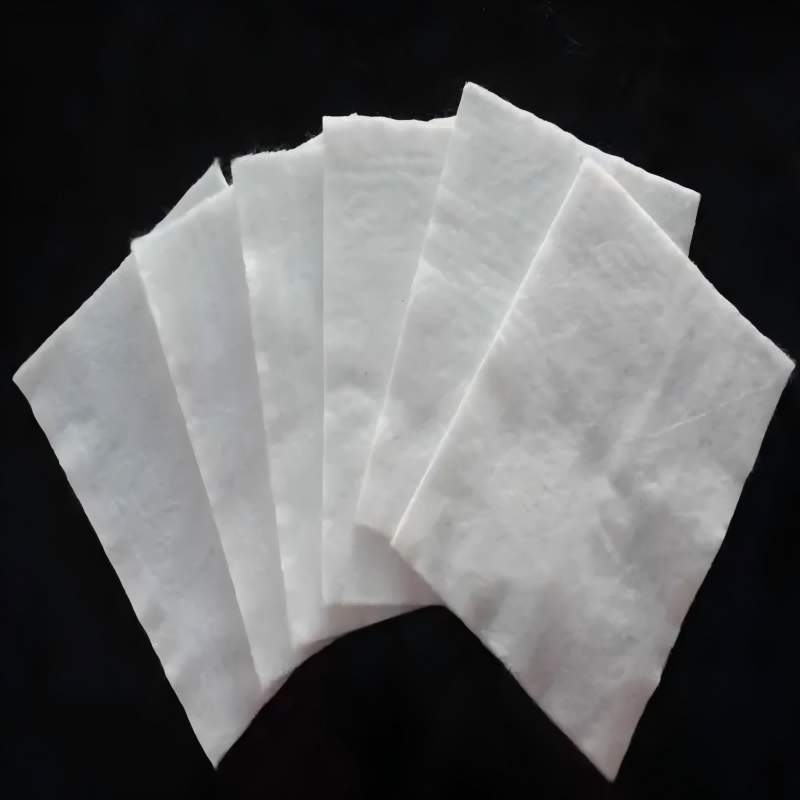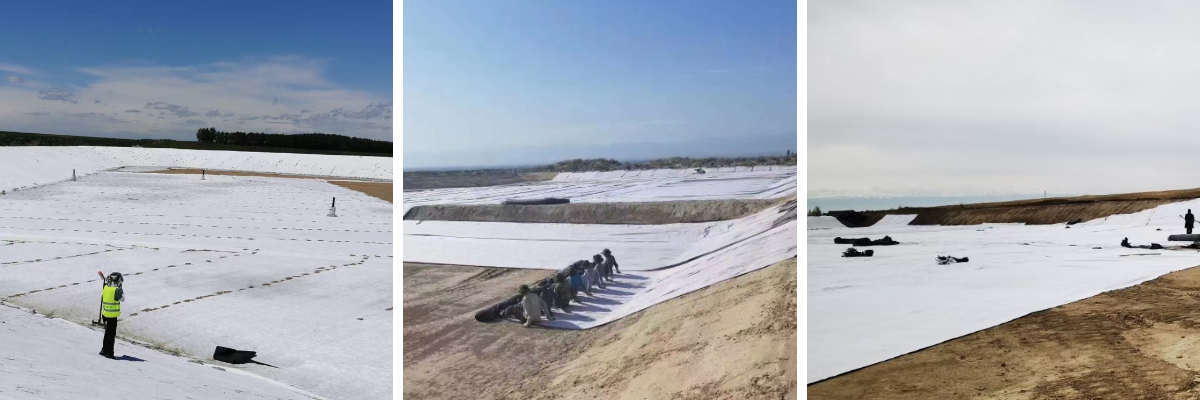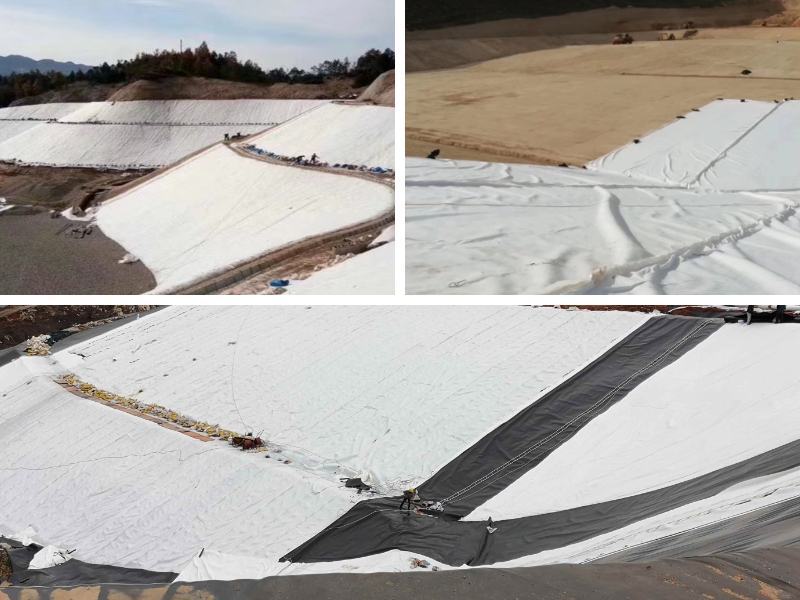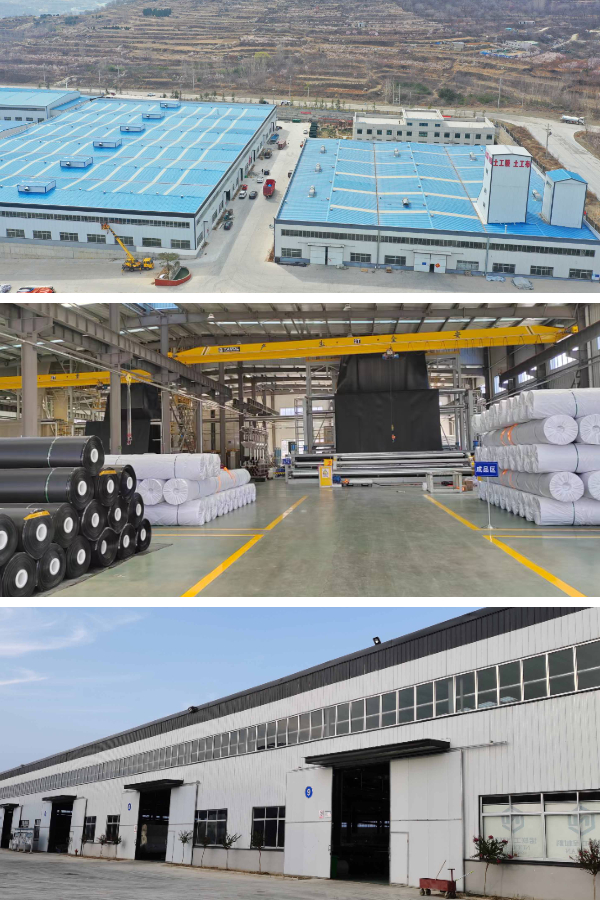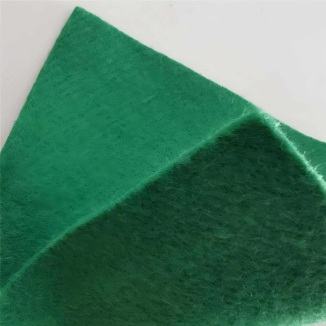Geotextile Stabilization
1. Strengthening the base layer: Enhances soil/roadbed integrity, reduces settlement and deformation, and prevents load-related cracking of pavements and slopes.
2. Erosion and corrosion resistance: Resists water erosion and soil erosion, tolerates acidic and alkaline environments, and maintains long-term structural stability.
3. Wide adaptability: Flexible and adaptable to complex terrain, meeting the reinforcement needs of various scenarios, including roads, embankments, and foundation pits.
4. Labor-saving and economical: Easy installation without complex equipment reduces construction costs and extends maintenance cycles.
Products Introduction:
Geotextile Stabilization is a functional geosynthetic material designed to solve the problem of insufficient bearing capacity and easy deformation of structural layers such as soil and subgrade. It is made of high-strength polypropylene (PP) and polyester (PET) as the core raw materials, and is made through weaving, needle punching, or coating processes. The core function focuses on "structural reinforcement and stability improvement" - through the synergistic effect with soil, sand, and gravel substrates, it enhances the overall integrity and shear strength of the substrate, reduces structural deformation caused by loads, water flow, or natural settlement, and provides long-term stable foundation support for various projects.
Different from ordinary geotextiles that focus on filtration and drainage, geotextile stabilized fabrics emphasize more on "mechanical performance and structural synergy". They have better fracture strength and creep resistance, and can replace traditional sand and gravel cushion layers or concrete reinforcement layers in scenarios with high stability requirements such as roads, dams, and foundation pits, achieving "lightweight reinforcement and low-cost quality improvement". They are widely used in engineering fields such as transportation, water conservancy, municipal engineering, and mining.
Product Features:
1. High strength reinforcement to enhance structural load-bearing capacity
Using high modulus fiber raw materials and dense weaving technology, the longitudinal and transverse fracture strength can reach 20-80kN/m, and the shear strength is 30% -50% higher than that of ordinary geotextiles. It can effectively disperse local loads borne by soil or subgrade (such as vehicle rolling and dam water pressure), evenly transmit stress to a larger range of substrates, and avoid settlement and collapse caused by local stress concentration; At the same time, it has excellent creep resistance and is not prone to plastic deformation even under constant loads for a long time, ensuring that the structural layer maintains a stable shape for a long time and is suitable for high-intensity use scenarios such as heavy-duty highways and mining yards.
2. Impact and corrosion resistance, resisting complex environmental damage
The raw materials have undergone anti UV, anti acid and alkali, and anti microbial treatment, and can be stably used in extreme temperature environments ranging from -30 ℃ to 80 ℃, resisting soil salt and alkali corrosion, groundwater immersion, and outdoor sun and rain exposure; The surface special coating (such as PVC coating) can enhance the ability to resist water erosion. In scenarios such as river bank slopes and roadbed slopes that are susceptible to water erosion, it can effectively prevent soil particle loss, avoid structural layer thinning and strength reduction due to erosion, and have a service life of up to 10-20 years, reducing maintenance frequency in the later stage.
3. Flexible and snug fit, suitable for various complex terrains
The texture combines toughness and ductility (fracture elongation of 15% -35%), and can naturally adhere to irregular base layers such as potholed roadbeds, curved embankments, steep slopes, etc., without blind spots for laying; Lightweight (150-500g/m ²), easy to cut, even in narrow excavations, curved ditches and other construction space limited scenarios, it can be quickly laid by manual labor or small machinery, solving the pain points of traditional rigid reinforcement materials (such as concrete slabs) that are difficult to fit and prone to cracking.
4. Collaborative compatibility, optimizing engineering structure design
Strong compatibility with soil, sand, and other substrates, it can form a "composite stable layer" with the substrate after laying, which not only does not hinder normal water infiltration (some models retain permeability, with a permeability coefficient of ≥ 1 × 10 ⁻⁴ cm/s), but also enhances interlayer adhesion and avoids separation of different structural layers; Simultaneously compatible with subsequent construction processes, such as asphalt paving, concrete pouring, vegetation planting, etc., without the need for additional adjustments to engineering processes, suitable for composite engineering requirements such as "reinforcement+ecological restoration" and "reinforcement+pavement paving".
5. Economically efficient, reducing comprehensive engineering costs
Compared to traditional reinforcement methods such as thickening the sand and gravel cushion layer and pouring concrete reinforcement layer, the material cost is reduced by 20% -40%, and the construction does not require large heavy equipment. The manual laying efficiency is 2-3 times higher than traditional processes, shortening the construction period; In long-term use, due to the improvement of structural stability, the maintenance cycle of the project is extended by 3-5 years, further reducing the later maintenance investment, especially suitable for the cost control needs of large-scale projects (such as rural road reconstruction and large-scale dam reinforcement).
Product Parameters:
project | metric | ||||||||||
Nominal strength/(kN/m) | |||||||||||
6 | 9 | 12 | 18 | 24 | 30 | 36 | 48 | 54 | |||
1 | Longitudinal and transverse tensile strength / (kN/m) ≥ | 6 | 9 | 12 | 18 | 24 | 30 | 36 | 48 | 54 | |
2 | Maximum elongation at maximum load in longitudinal and transverse directions/% | 30~80 | |||||||||
3 | CBR top penetration strength /kN ≥ | 0.9 | 1.6 | 1.9 | 2.9 | 3.9 | 5.3 | 6.4 | 7.9 | 8.5 | |
4 | Longitudinal and transverse tearing strength /kN | 0.15 | 0.22 | 0.29 | 0.43 | 0.57 | 0.71 | 0.83 | 1.1 | 1.25 | |
5 | Equivalent aperture O.90(O95)/mm | 0.05~0.30 | |||||||||
6 | Vertical permeability coefficient/(cm/s) | K× (10-¹~10-), where K=1.0~9.9 | |||||||||
7 | Width deviation rate /% ≥ | -0.5 | |||||||||
8 | Unit area mass deviation rate /% ≥ | -5 | |||||||||
9 | Thickness deviation rate /% ≥ | -10 | |||||||||
10 | Thickness coefficient of variation (CV)/% ≤ | 10 | |||||||||
11 | Dynamic perforation | Puncture hole diameter/mm ≤ | 37 | 33 | 27 | 20 | 17 | 14 | 11 | 9 | 7 |
12 | Longitudinal and transverse fracture strength (grab method)/kN ≥ | 0.3 | 0.5 | 0.7 | 1.1 | 1.4 | 1.9 | 2.4 | 3 | 3.5 | |
13 | Ultraviolet resistance (Xenon arc lamp method) | Longitudinal and transverse strength retention rate% ≥ | 70 | ||||||||
14 | Ultraviolet resistance (fluorescence UV lamp method) | Longitudinal and transverse strength retention rate% ≥ | 80 | ||||||||
Product Applications:
1. Transportation infrastructure engineering
Highway/railway subgrade reinforcement: laid between the soft soil layer and the sand and gravel cushion layer of the subgrade, enhancing the overall shear strength of the subgrade, reducing the settlement and uneven deformation of the subgrade caused by vehicle loads, avoiding cracks and ruts on the road surface, suitable for highways, heavy-duty railways, rural hardened roads and other projects, especially suitable for soft soil subgrade, filled embankment and other easily deformed scenarios.
Stability of parking lot/freight station ground: It is laid between the gravel base and asphalt/concrete surface of the parking lot and logistics freight station to enhance the ground bearing capacity, resist long-term crushing by heavy vehicles such as trucks and forklifts, prevent ground depression and cracking, and adapt to heavy-duty scenarios such as residential parking lots and industrial park freight stations.
2. Water conservancy and slope protection engineering
Reinforcement of river/reservoir embankments: laid between the soil and protective layer (such as ecological gabions, precast concrete blocks) on the upstream or downstream slope of the embankment, to enhance the stability of the embankment soil, resist landslides and pipe surges caused by water flow erosion and water level changes, and provide a foundation for vegetation growth, suitable for small and medium-sized reservoir embankments and river flood control embankment reinforcement projects.
Slope/foundation pit support: Lay in the soil layer of highway slopes and building foundation pits to form a "reinforced stable layer", enhance the anti sliding ability of the slope, and prevent slope collapse; When cooperating with spray seeding greening, it can serve as an attachment carrier for vegetation roots, achieving synchronous "reinforcement+ecological restoration" and adapting to scenarios such as highway slope treatment and temporary support for building foundation pits.
3. Municipal and Construction Engineering
Ground reinforcement of municipal roads/squares: used between the roadbed and ground base of urban secondary roads and municipal squares to enhance the ground's resistance to deformation, reduce ground subsidence caused by backfill soil settlement after underground pipeline construction, and adapt to projects such as road renovation and new municipal squares in old urban areas.
Building foundation treatment: Lay between the weak foundation and sand and gravel cushion layer of buildings (such as factories and warehouses) to improve the stress state of the foundation, reduce uneven settlement of the foundation, avoid cracking of building walls and tilting of equipment foundations, and meet the foundation reinforcement needs of heavy-duty factories and multi story buildings.
4. Mining and yard engineering
Reinforcement of mine tailings pond: It is laid between the soil base layer and the anti-seepage layer of the tailings pond dam body to enhance the stability of the dam body, resist the deformation and leakage of the dam body caused by tailings loading and rainwater erosion, and prevent the loss of fine tailings particles. It is suitable for safety reinforcement projects of metal and non-metal tailings ponds.
Ground stability of bulk cargo yards: Lay under the gravel base of coal, ore and other bulk cargo yards to enhance the ground bearing capacity, avoid ground subsidence caused by bulk cargo loading and heavy machinery rolling, reduce yard maintenance frequency, and adapt to scenarios such as port bulk cargo yards and industrial park raw material yards.
5. Agricultural and ecological restoration projects
Reinforcement of agricultural irrigation channels: Laying on the slopes and bottom soil layers of agricultural irrigation channels to enhance the stability of the channel soil, resist channel collapse and siltation caused by water flow erosion, reduce channel leakage, improve irrigation water utilization efficiency, and adapt to large-scale agricultural water conservancy renovation projects.
Ecological wetland/landfill cover: It is laid in the soil base layer of ecological wetlands or the sealing cover layer of landfills to enhance the stability of the cover layer, prevent cracking and loss caused by rainwater erosion and vegetation root growth, and adapt to wetland ecological restoration and landfill sealing projects.
Geotextile Stabilization, with its core advantages of "high-strength reinforcement, impact and corrosion resistance, flexibility and adaptability, and economic efficiency," accurately solves the core pain points of "insufficient structural bearing capacity, easy deformation, and high maintenance costs" in civil engineering. It is a key material for achieving "lightweight reinforcement and long-term stability" in various engineering projects. Whether it is roadbed protection in transportation engineering, dam reinforcement in water conservancy engineering, or ground stability in municipal projects, they can significantly improve structural stability and extend the service life of the project through the synergistic effect with the substrate.
Compared with traditional reinforcement materials and processes, geostable fabric has achieved triple optimization in "performance, cost, and construction efficiency" - breaking through the limitations of rigid materials, reducing overall project investment, and adapting to the needs of modern engineering for "green environmental protection and efficient construction". Its widespread application not only promotes the upgrading of civil engineering reinforcement technology, but also provides reliable support for reducing long-term operation and maintenance costs and ensuring engineering safety. It is an indispensable functional geotechnical material in modern infrastructure construction and ecological engineering.


